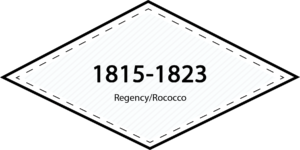
“Renaissance of the Renaissance”
Liberation of sorts for women with the fast pace of industry creating desire for the “simple life”


—— THE ERA IN BRIEF ——
Regency took an interesting turn to add flare & flounce taken from the historical pasts of Renaissance, Gothic, & Roccoco. Following a train of thought that “man is the measure of all things”, some women stepped back in time to study Latin & The Masters, while others moved forward to run a sewing machine in a factory.

—— PORTRAITS OF REAL WOMEN FROM THE ERA ——
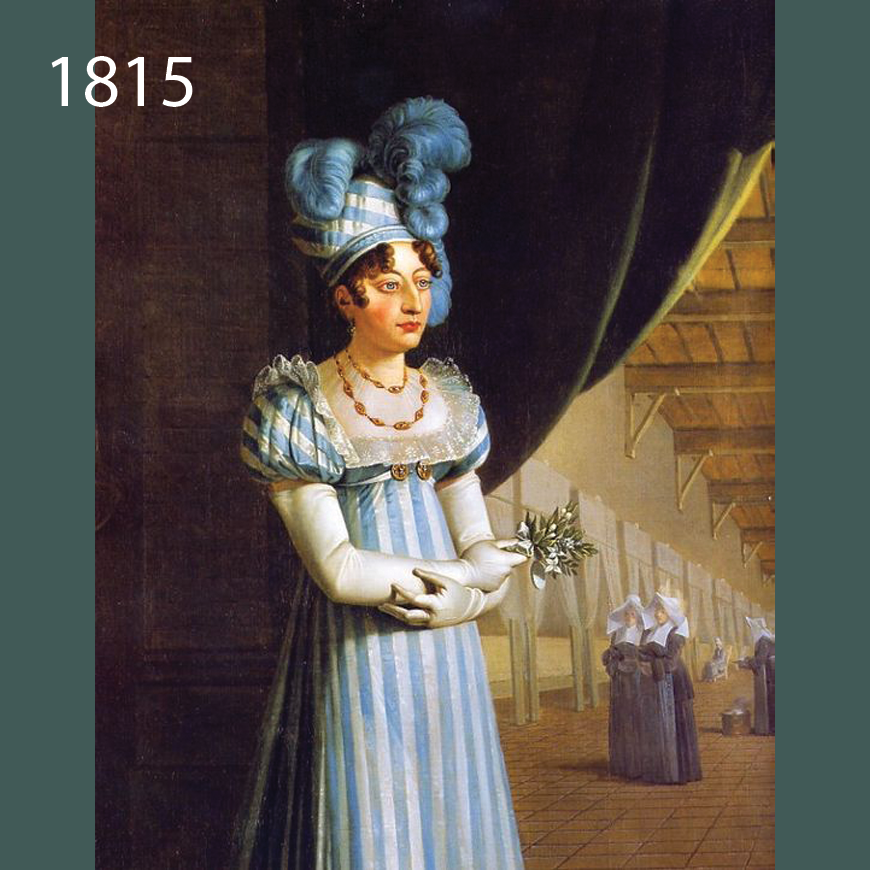
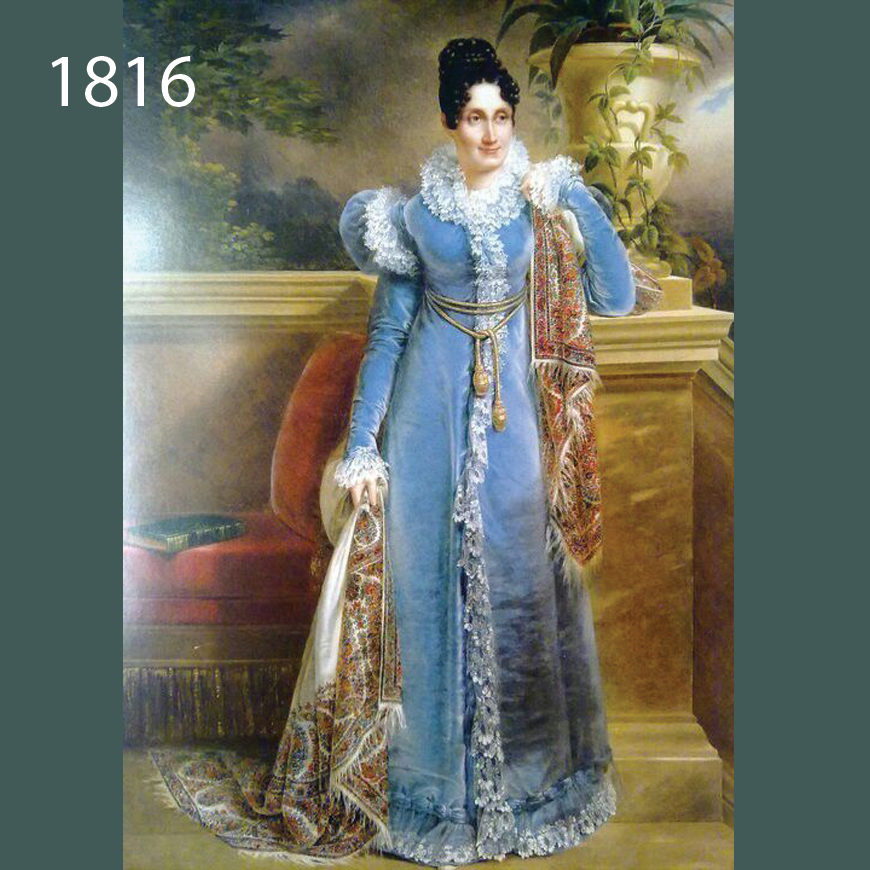
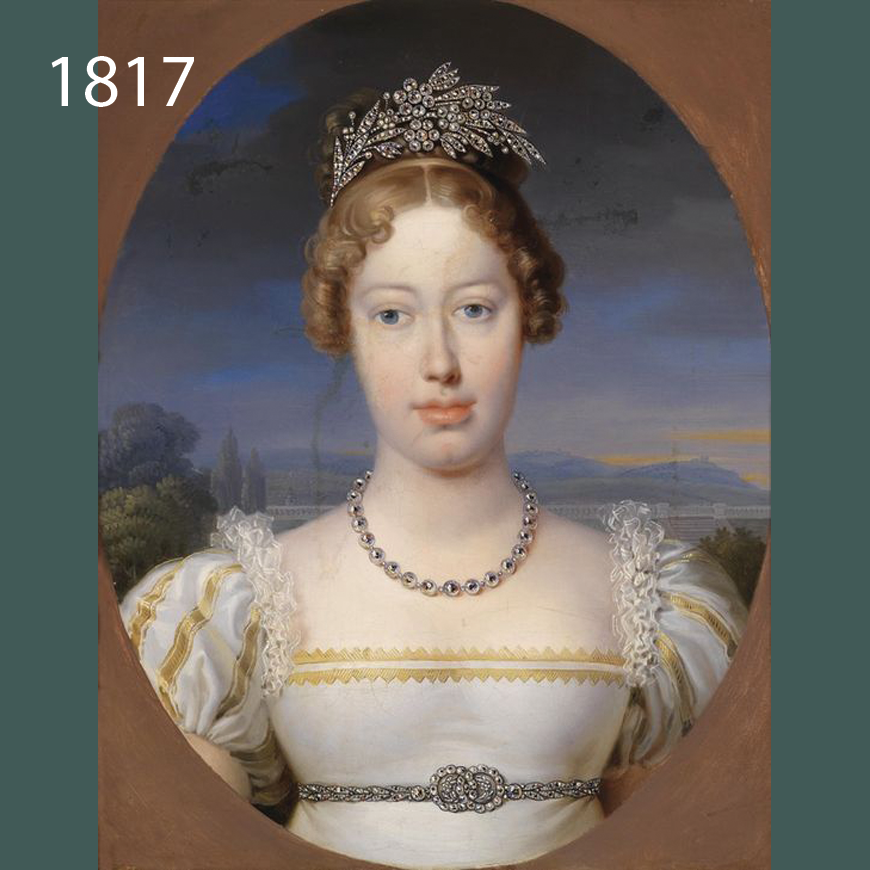
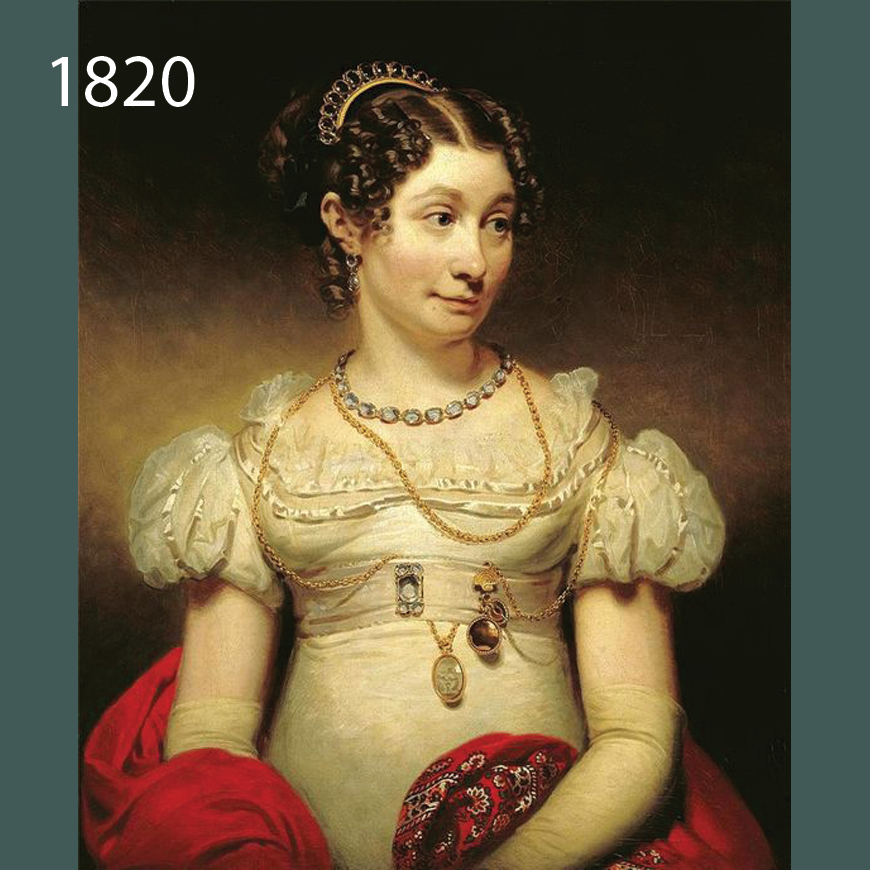
—— WORLD SITUATION ——
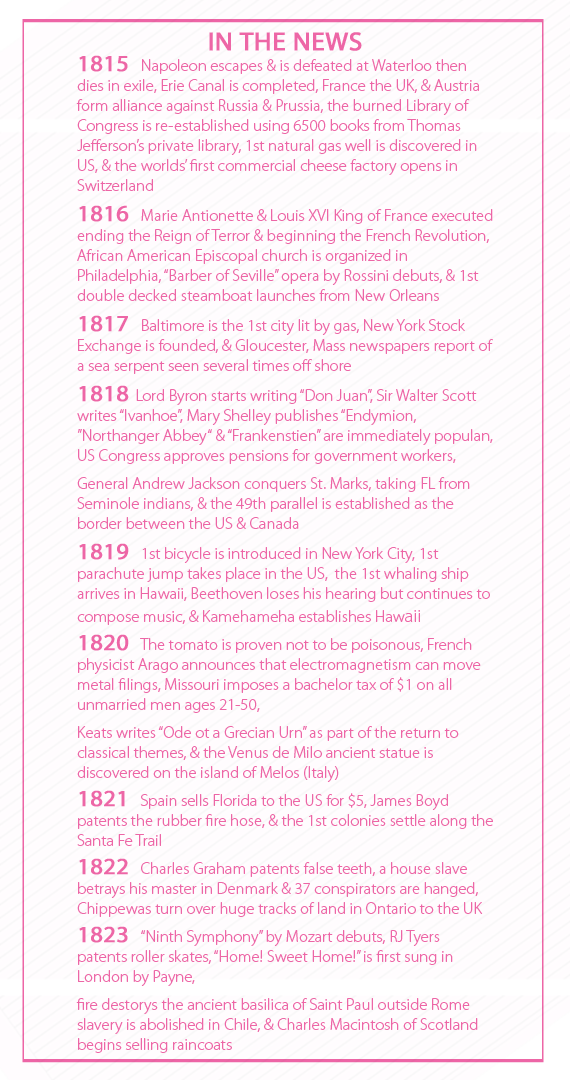
NEW THINKING
- Napoleon had been banished, though French influence remained
- 1814 marked the end of the British/French wars with the Treaty of Paris which reassigned French territory retroactive to that of 1792
- Desire for a simpler life brought back ideals of chivalry & romance of the Middle Ages & the Renaissance
- The peak of the young, wealthy, & rising middle class to parade & do “social rounds” was in 1817
- Social change for women of high status continued; laboring women continued to labor
- Technology & invention continued; as did war, conflict, & political power exchange as the European “continent” continued their quest for expansion through colonization
- American culture developed with the arts & humanities; building of opera-houses, universities, & humanitarian organizations
- America led cotton production from field-to-mill by 1820, shifting the balance of trade worldwide
- America was expanding political structures as the country expanded, & the Renaissance spirit applied there to some degree too
OLD THINKING
- People of this time were adhering to the Renaissance philosophies
- Renaissance had “Humanism” as its intellectual basis
- This philosophy came from the rediscovery of classical Greeks such as Protagoras, who said that “Man is the measure of all things.”
- Renaissance was in part a revolution of many intellectual pursuits, as well as social & political upheaval
- This mode of thinking became manifest in art, architecture, politics, science & literature
- Renaissance “style” encompassed innovative flowering of Latin & vernacular literature such as Petrarch, & the gradual but widespread reform of education
- In Renaissance based politics & science, customs & conventions of diplomacy relied upon observation & inductive reasoning
- Art & literature of the era were philosophical
- Renaissance art strove to portray the human form realistically in natural light
- Artists of the Renaissance like Leonardo da Vinci & Michelangelo were credited with the development of linear perspective & other techniques of rendering a more natural reality in painting. This concept would pervade all art forms in this era including fashion
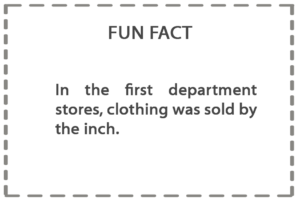

—— INTERESTING FACTS OF THE TIME ——
MASS PRODUCTION
- As war & conquest changed countries, trade between them, & especially to & from the Americas, was affected
- With Napoleon’s end at Waterloo in 1815, clothing style enforcements & restrictions ended
- Fashion had become isolated during war times; e.g. English women developed their own variations of style separate from the French
- After the Wars, the French embraced the ideas the English had come up with
- Inventions continued & were now applied to assembly line & mass production
- War was the inspiration for mass production to make uniforms
- American whale fishermen also needed particularly tough, warm garments
- The first production sewing machines were made to handle extremely tough fabrics such as leather & wool for the military & fishermen
- In 1821, a poor French tailor got the contract for the French army to use the new machines to mass produce uniforms, but the tailor’s guilds destroyed them because they thought guilds would be put out of work
- With mass production in full steam (literally, as they were steam-powered), cotton mills in America were highly productive
- England could not keep up with demand because they could not sew garments as fast at the textiles were being made
- Because so much fabric was now available from the US & Europe, hand sewing became the problem in slowing the entire textile & garment industry down
- The inability of hand sewing to keep up with the otherwise mass production led to further innovations in sewing & cutting machines to handle lighter fabrics & more variety of projects than could be done by the first heavy duty machines
- Sewing machines were first designed so one had to stand to use them, & they were only used in factories
- Sewing machines in this era did not rescue women from drudgery, but instead put them into factories
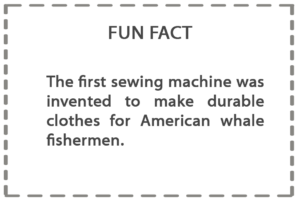
READY-TO-WEAR
- Ready-to-wear became available due to mass production, though in limited form at first
- The first department stores were opened in England & America in this ear. These were more like a shopping district similar to today’s suburban malls
- Brooks Brothers was the flagship department store of the world in 1818. It would sell the suit to Abraham Lincoln that he was wearing when he was assassinated
- Brooks Brothers introduced button down shirts
- In the first department stores, clothing was sold by the inch, & eventually sizes were standardized so the merchant could charge on the “heavy” side
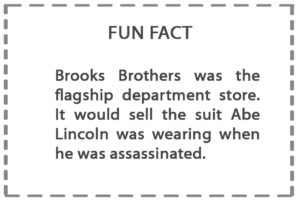

—— FASHION TRENDS ——
BRITAIN COPIES FRANCE THEN FRANCE COPIES BRITAIN
- This era signaled the loss of any lingering neoclassical, pseudo-Grecian styles in women’s dress
- This decline was especially evident in France due to Napoleon’s continued suppression of trade in the fabrics used in the neoclassical dress, as he was promoting French laces & trims & high end fabrics to boost the economy
- Britain copied French fashion again after 1815, so the waists went down “a la francaise” (“per French”), & there was a bit less ornamentation until 1816
- Fabric changed from simple muslin to pastel colored stiff fabrics, & then to heavier & more elaborate fabrics & trims as the era went on
- After 1814, at the end of the British/French wars, the waists rose for a bit, hems got wider, skirts were padded, & there was much decoration
- Narrower waists came from using whalebone reinforcements in the stays, but was mostly done through visual tricks which exaggerated the top & bottom of the garment to make the waist seem or appear to be smaller (grommets in 1828 would change that to real lacing soon)
- In 1816-17, the waist rose again to the highest yet just under the breast, & then it came back down & stayed there (except for Artistic renaissance in the Victorian eras for dance & theatre)
- From 1820-1837 the “Gothic” influence remained. It was a “chocolate box” image of contrasts; e.g. military male looks good with female dress
- The Romantic & Renaissance spirit ran parallel with Early Victorian until 1850
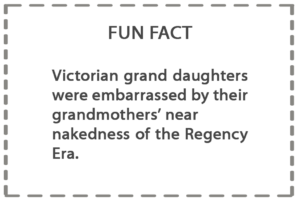
REGENCY WAS EMBARRASSING
- Later, during the first half of the Victorian era, the 1795-1820 Regency period would be frowned upon by the next generation. People would be uncomfortable to be reminded their mothers & grandmothers had promenaded wearing very little, & were empathizing with heroines in art & literature, or of ancient times. The Victorians considered these styles to be indecent
- Because of the embarrassment during the later Victorian era about this era, depictions of women & fashion would be altered, or simply not show women. Paintings of the Napoleonic Wars in particular changed women’s ensembles to depict later ones from the 1840’s
- In Charlotte Bronte’s 1849 (Victorian) novel “Shirley”, the Greek Regency fashions were changed in description to 1840’s styles when the author reflected on the Regency generation
- As time went on, Regency would become less threatening to the Victorians to the point fashion elements would be brought back by the “Artistic Dress Movement”
- During the late Victorian & Edwardian periods, many genre paintings, sentimental Valentines, & other forms of commonly used art would include depictions of the Regency styles
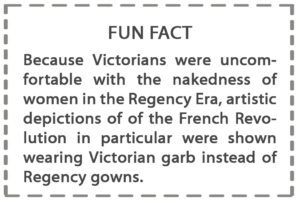
—— SPECIFIC TO THIS ERA ——
GOWNS
- There were no trains except for Court wear
- The center back of the gown was always straight
- The bodice started the era very high-waisted though it varied slightly
- At the time most waistlines were high, some were beginning to drop slightly
- After a few years the waist jumped to its highest ever, & then came back down suddenly
- From 1820 on, the bodice lengthened, & was set into a waist band
- Skirts were not at the natural waistline yet, but getting there
- Skirts widened, though not to extremes that would come next
- At first, & for simple dresses, the skirt was cut from two pieces & the front was gored at each side
- The skirt was always gored now (not gathered as previously)
- The angle of the gores became more acute as the era progressed & the skirt widened
- Yet an additional gore was also added later in the era to each side to keep making the skirt still wider
- By 1825, the straight line of the 1810 skirt had widened at the base to become very triangular
- A stiffer, more cone-shaped skirt was the norm by 1825
- Slight whale bones in the skirts held them out
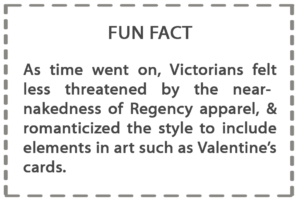
UNDERGARMENTS
PETTICOATS
- Stiffness to hold the new triangular skirt out was done by layers of ruffles & tucks on a hem
- Flounced & padded, corded petticoats were commonly used
- A corded petticoat was one in which piping was added in multiple rows along the bottom of the skirt
- The cords, like those used in stays, maintained the shape without adding weight or discomfort
- Multiple petticoats were being worn, although they were somewhat hidden (as if embarrassed to have returned?)
- The number of petticoats did not depend so much on class, status, or function as it had in previous eras
- The number depended on how many it took to create the shape of the skirt
- Some women, particularly the French, had been wearing pantaloons under their gowns, but it was not common
CHEMISE & STOCKINGS
- It was more typical for a woman to wear a long body stocking or stockings with stays than a chemise at first
- A short soft muslin or plain white cotton chemise was worn under the stays STAYS
- Stays worn for daily wear continued to be lightly boned or corded as per the previous eras
- Riding stays were very short, & often buttoned instead of laced
- Riding stays were corded with necessary support depending on the size & shape of the individual
- Stays followed the waistline as it progressed down towards the natural line
- “Jumps” were a popular term for a short, lightly corded & slightly boned stay
- “Jumps” were more like an inside vest for modesty instead of shaping
- As metal grommets & busks had not yet been invented, stays were still used mostly for modesty, or to gently smooth or support places that needed to be smoothed
- At the end of the era corsets had increasingly fuller shapes on top, & a modeled basque below the waist
- The result was a cone-shaped, triangular silhouette
- This shape continued to be further exaggerated as the century progressed
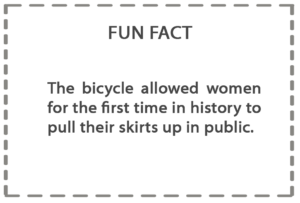
SLEEVES & FLOUNCES
- Early on, sleeves were pulled, tied, & pinched in ways that were more influenced by romantic & Gothic styles than neoclassical
- From 1820 on, upper sleeves widened through the era until they began to drop over the shoulder
- Flounced epaulettes on the shoulders expanded to became the ornate “mancherons” which were much worn, especially in the 1820’s with the larger sleeve
- Sleeves became long & full, & were often stuffed to keep them wide (a look that would reappear in the 1890’s as huge elephant ears or legs o’mutton)
- Sleeves ended at demure cuffs at the wrist
- A long transparent sleeve was worn over the short puffed on an evening dress
- Larger & more abundant decoration, especially near the hem & neckline, foreshadowed greater extravagance in the coming years
OUTERWEAR
- Women’s liberation was expressed by riding horses & wearing “daring” riding habits
- Riding & racing horses demanded highly functional clothing that could bend at the hip
- Women had been wearing boots to ride even when they would not do so even doing farm chores
- Women wore a full ensemble similar to what men were wearing
- Riding gear would include a fitted jacket with flare over the hips, plus a long skirt that completely covered the legs & ankle
- Skirts, except in the American West, would not be split nor approach the design of pants until well into the 1870’s
- In 1815, because men’s fashionable coats did not close shut & women’s garments were so thin, cloaks became very popular
- The Redingote of the previous century made a reappearance
- Made of very heavy wool the Redingote appeared & looked odd in combination with a light silk or cotton gown
HEADGEAR
- Hats & hairstyles became more elaborate & trimmed.
- Hats & hair climbed higher
- Bows, ribbons, furbelows replaced simple hair
- Hair was worn in whimsical sausage curls

—— GARMENTS FROM ERA ——
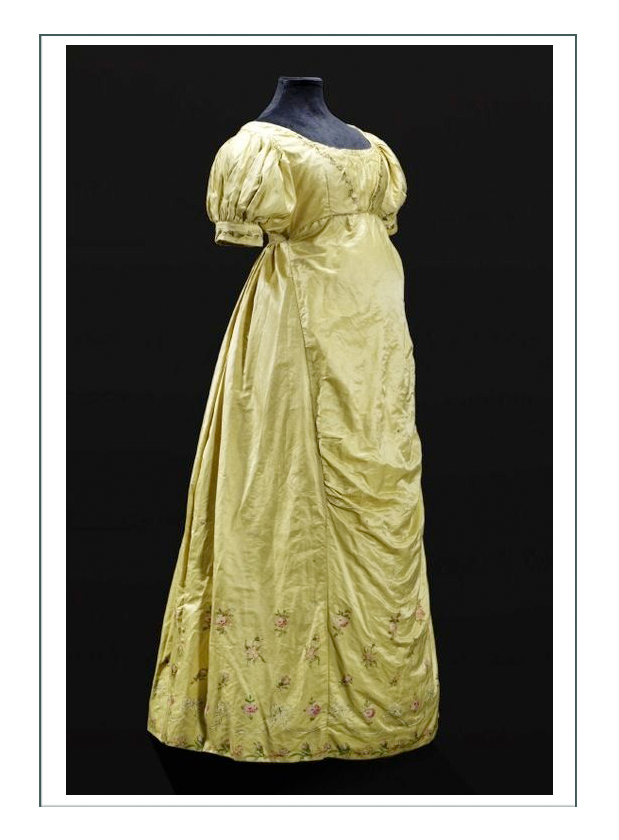
—— (above) “Maternity (Increasing) Gown 1815” ——
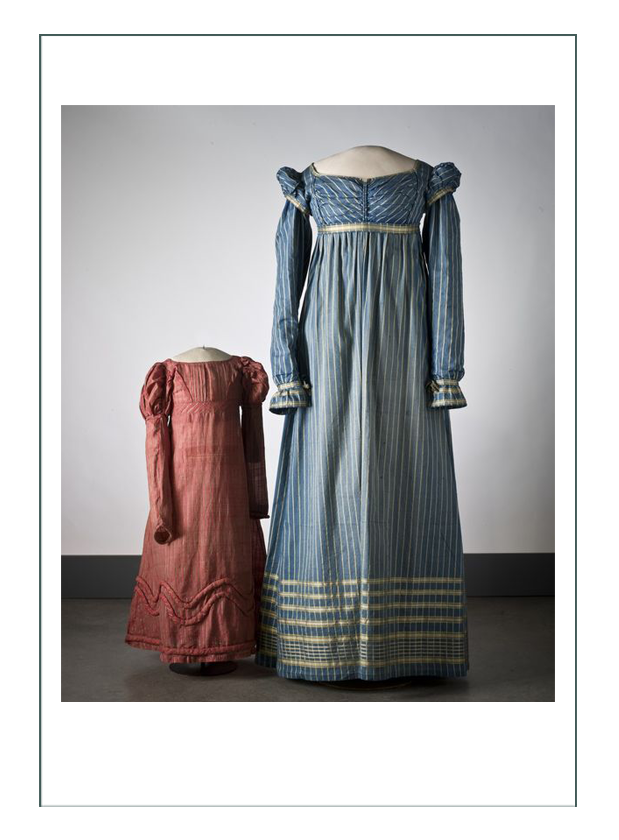
—— (above) “Mother & Child 1815” ——
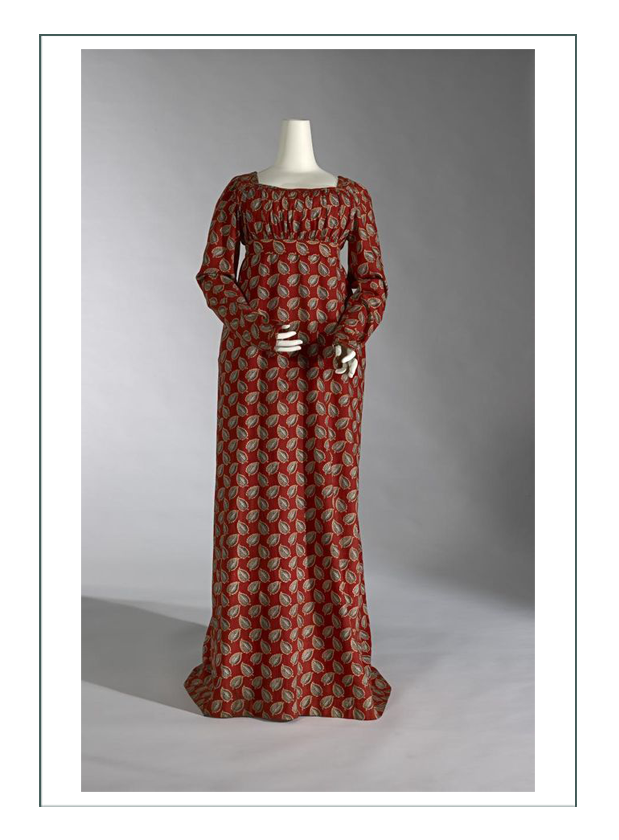
—— (above) “Indian dyed cotton Day Gown 1815” ——
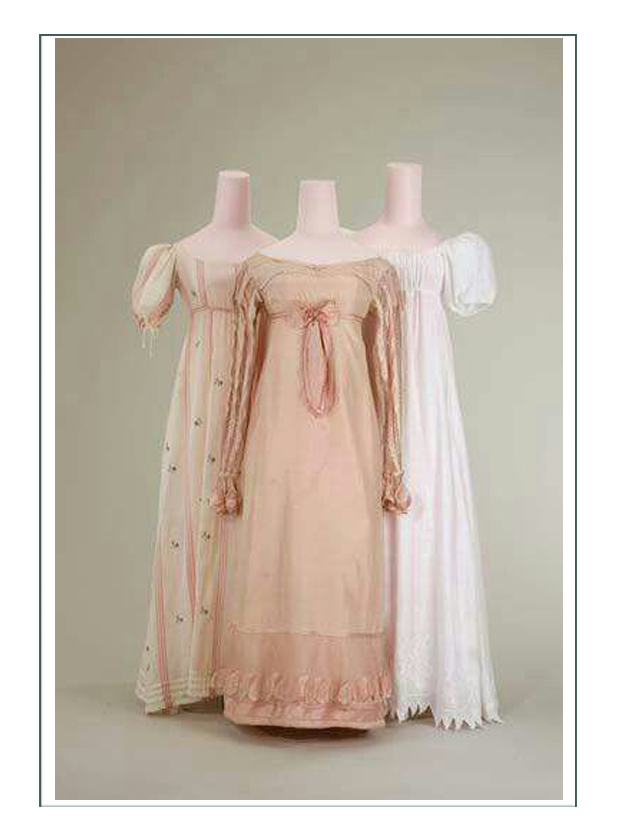
—— (above) “Maiden Evening Gowns 1815” ——
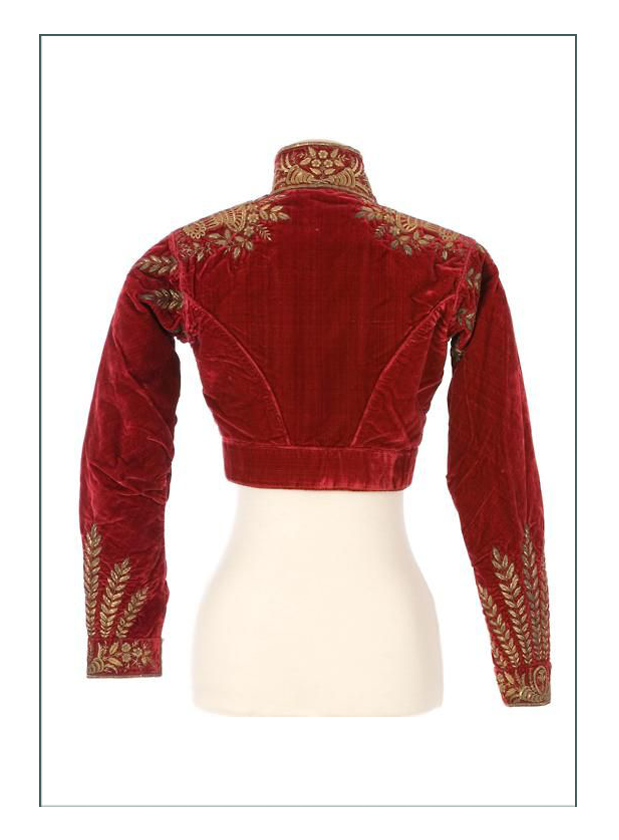
—— (above) “Spencer Jacket with Embroidery 1815” ——
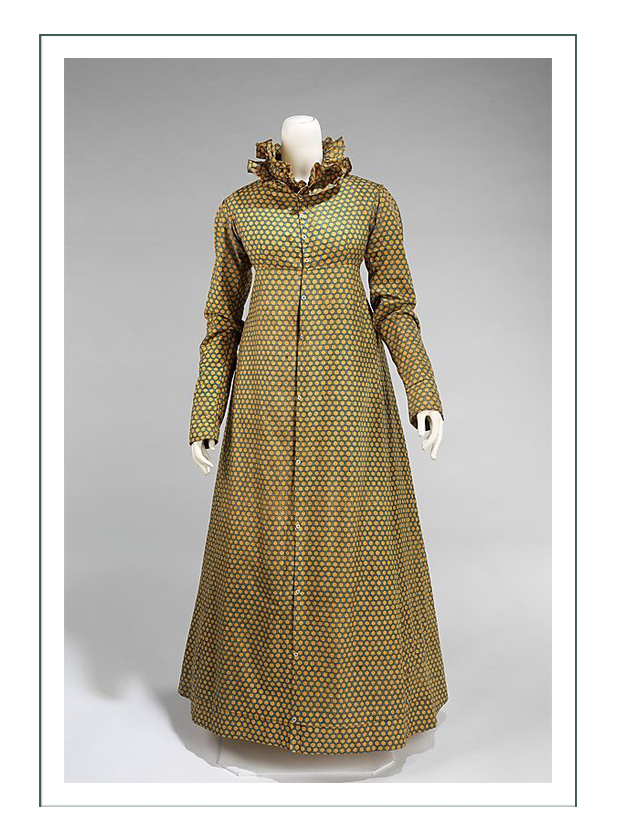
—— (above) “Pelisse 1815” ——
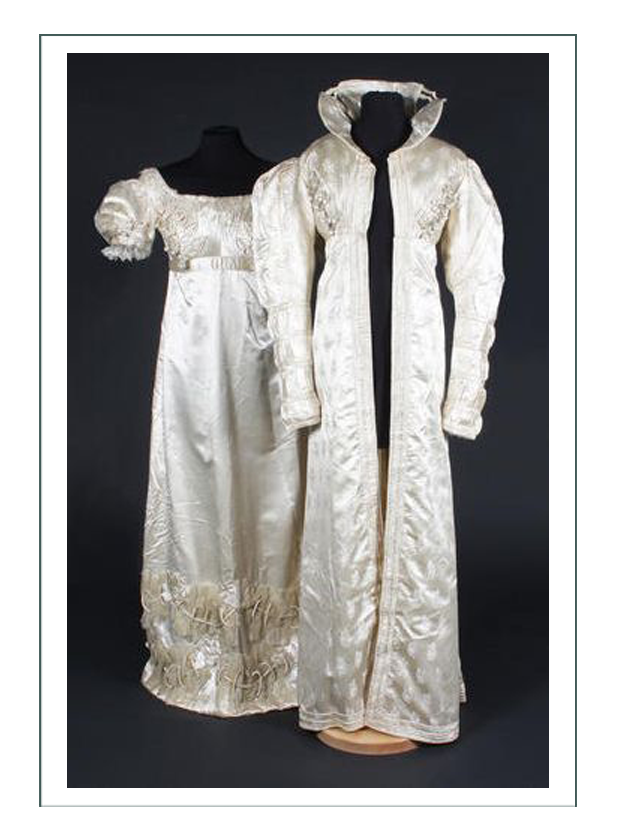
—— (above) “Redingote 1816” ——
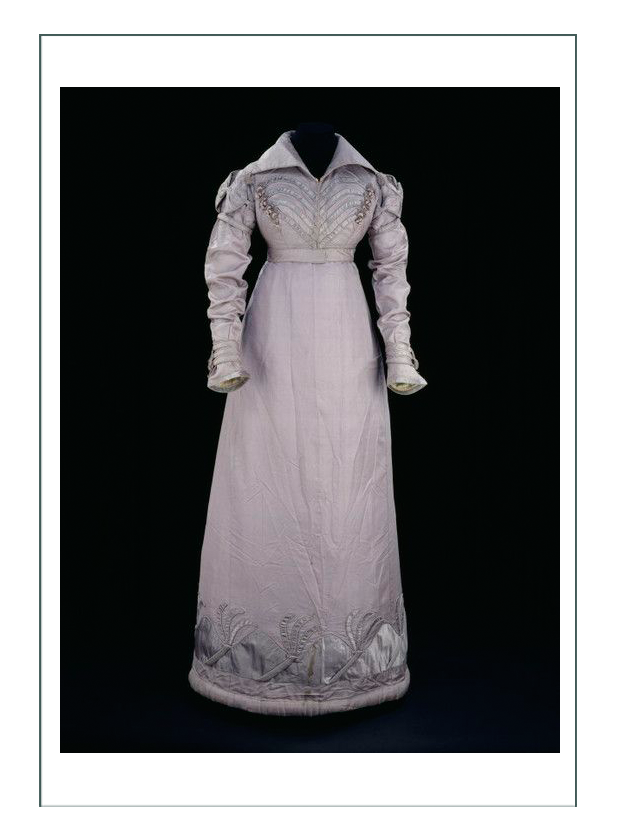
—— (above) “Traveling Dress 1817” ——
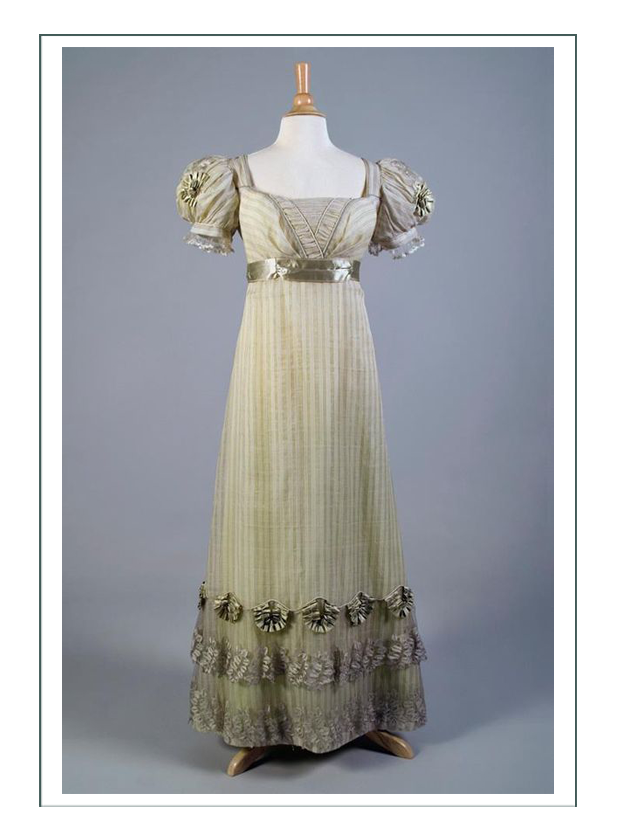
—— (above) “Formal Wear 1818” ——
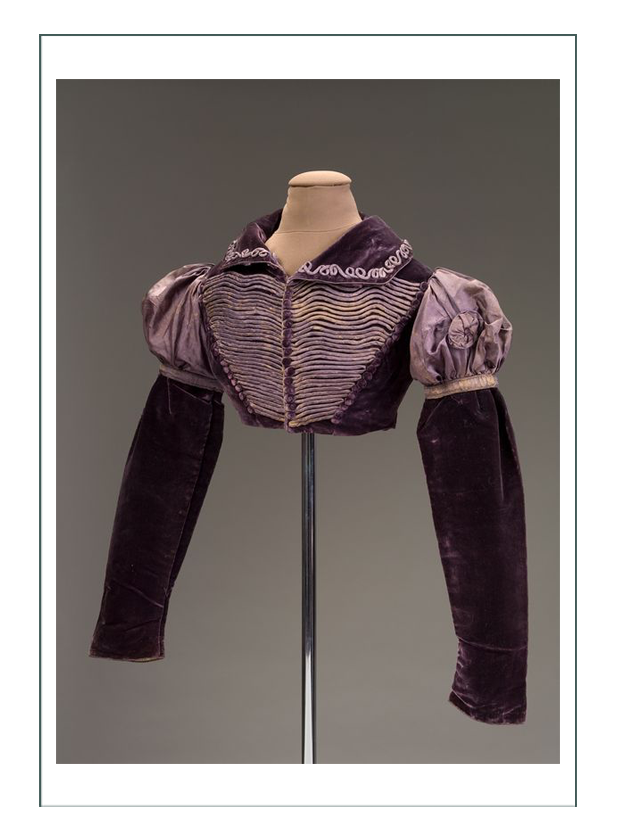
—— (above) “Spencer Jacket 1818” ——
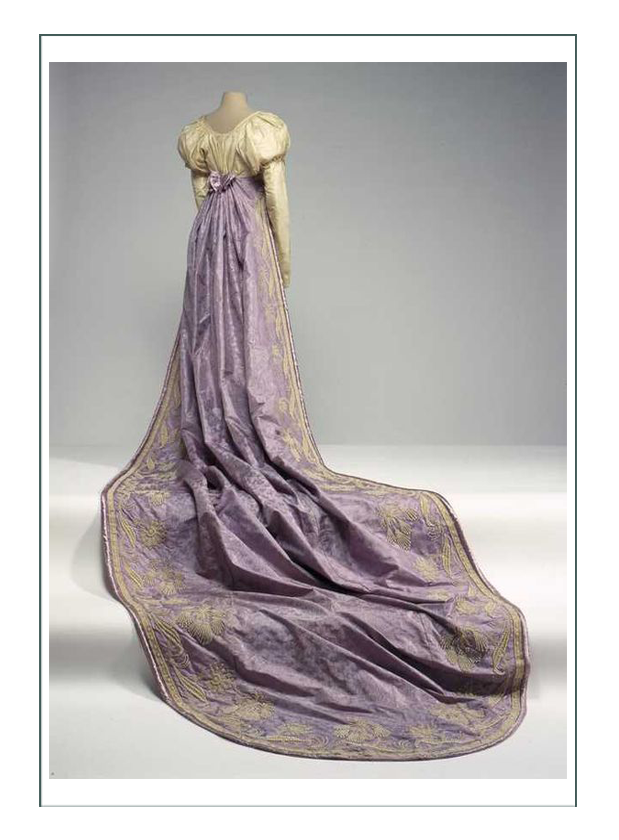
—— (above) “Court Gown 1818” ——
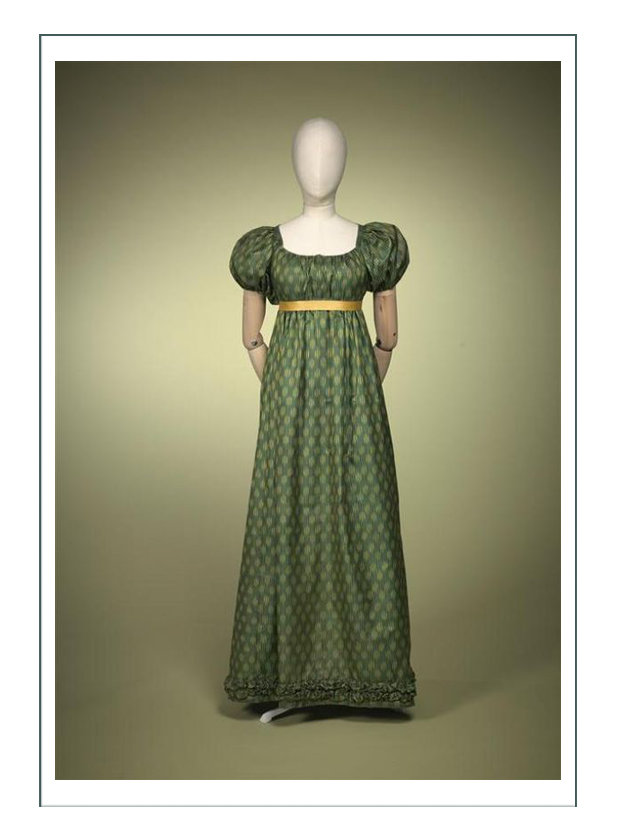
—— (above) “Day Dress for All 1819” ——
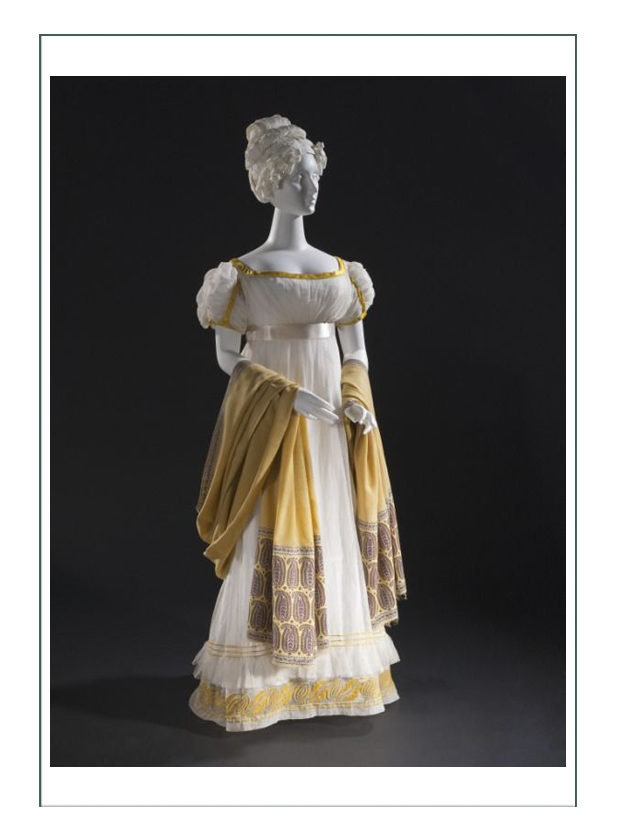
—— (above) “French Court Gown 1819” ——
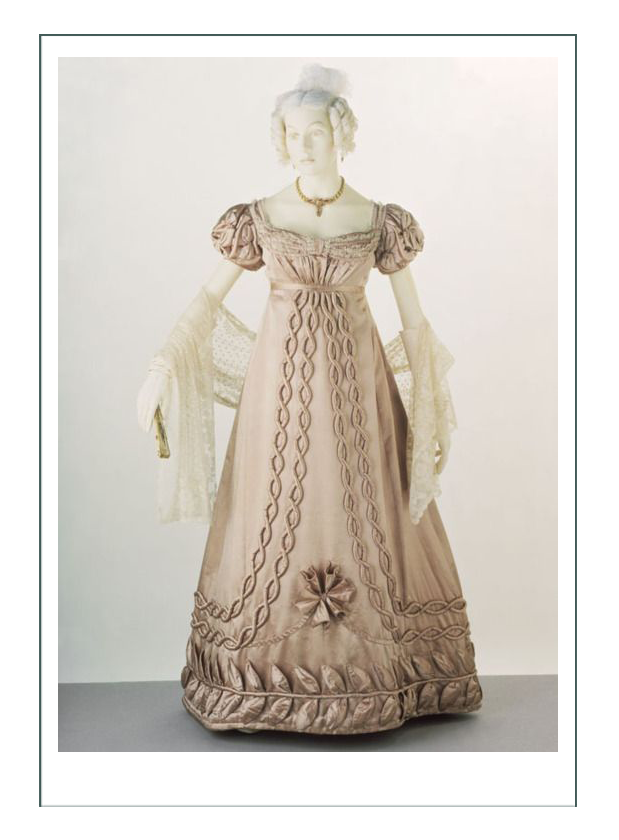
—— (above) “Evening Gown 1820” ——
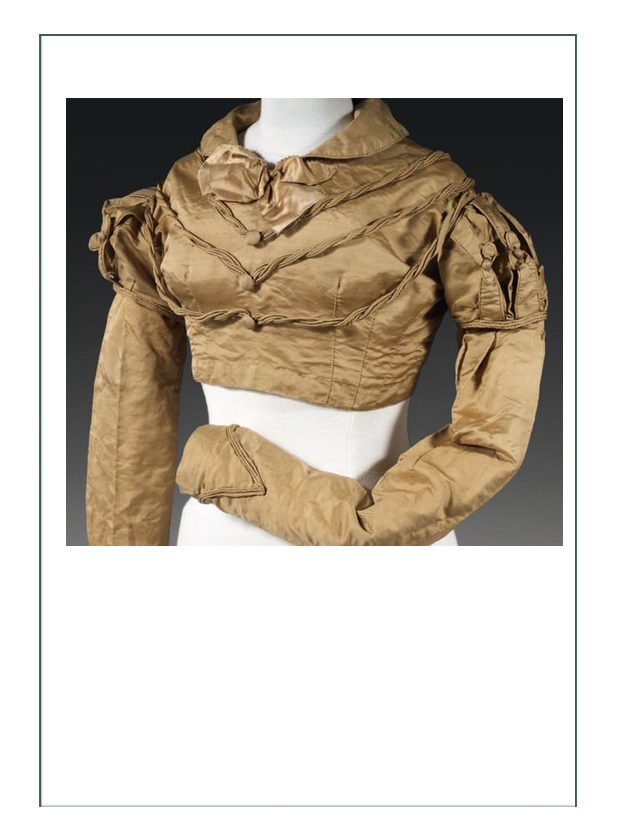
—— (above) “Spencer Jacket 1820” ——
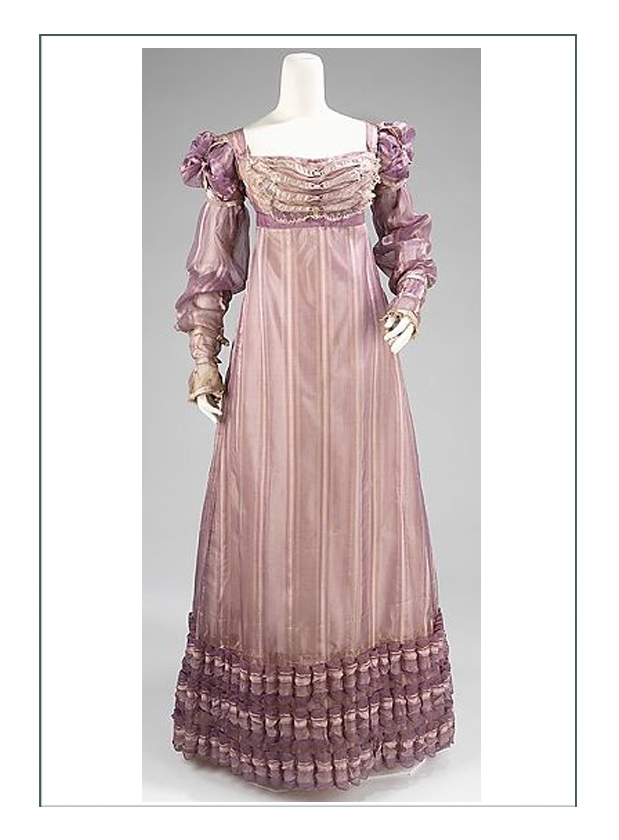
—— (above) “Silk Gown from France 1820” ——
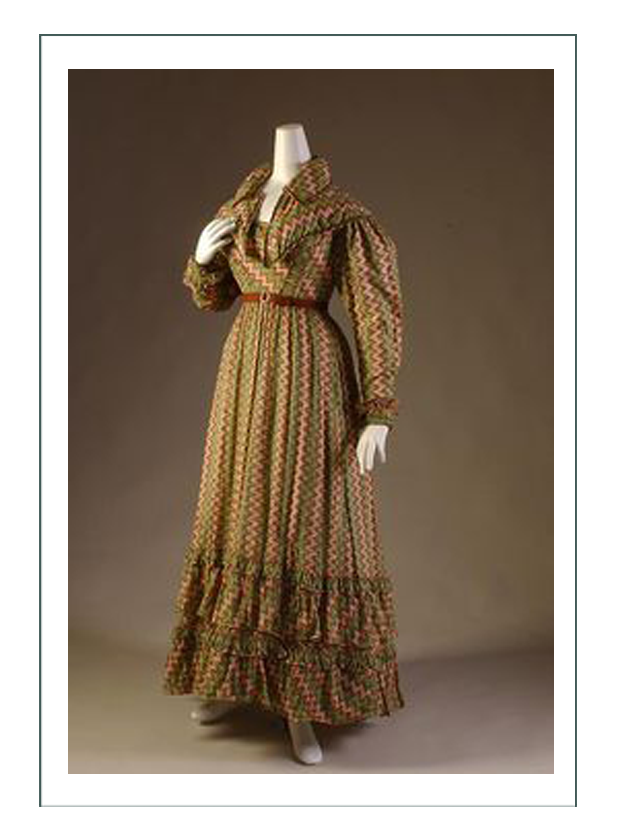
—— (above) “Gown of Batik Fabric 1821” ——
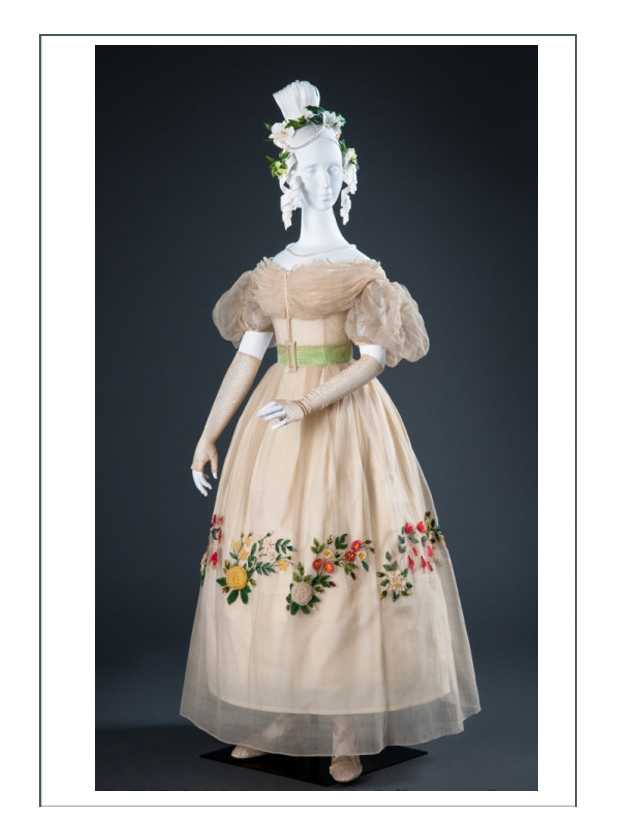
—— (above) “Evening Gown 1821” ——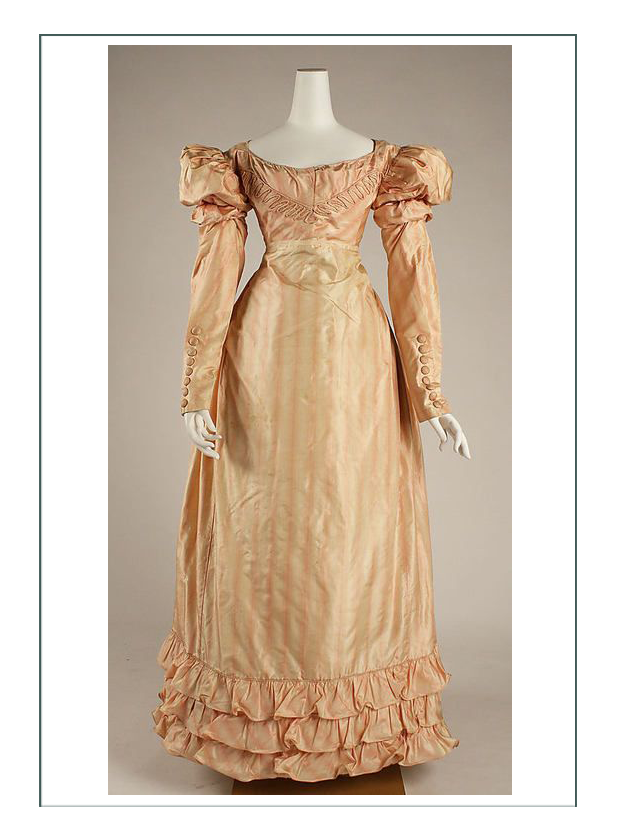
—— (above) “Silk Visiting Gown 1822” ——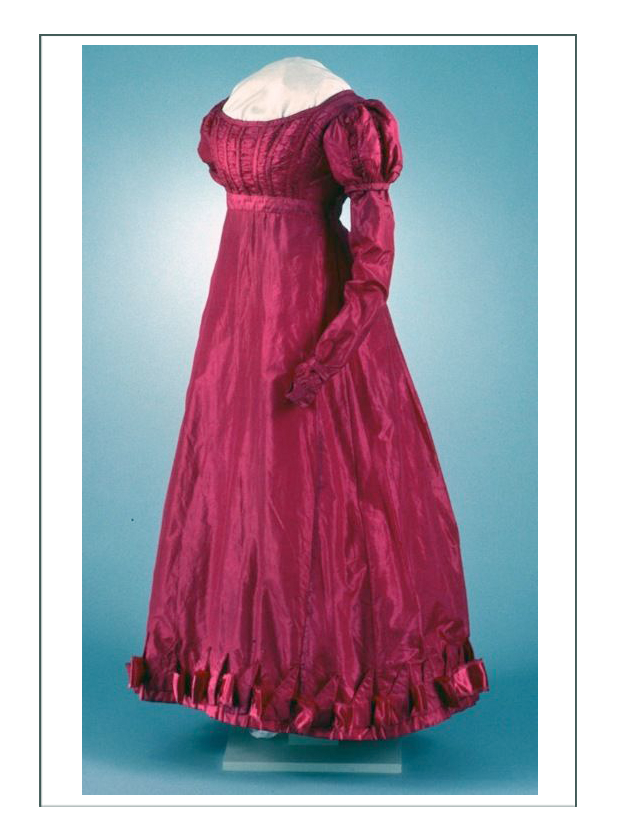
—— (above) “Day Dress from Williamsburg 1823” ——
Click to go to top of page
Click date below to go to a different era. We can replicate most ANY garment you see!


